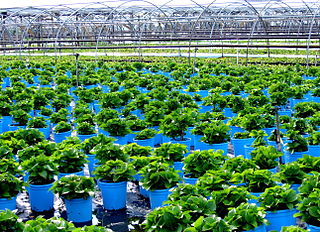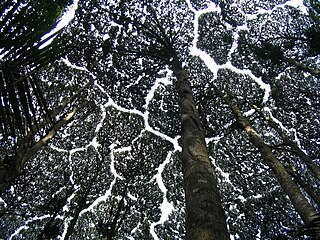Related Research Articles

A spruce is a tree of the genus Picea, a genus of about 35 species of coniferous evergreen trees in the family Pinaceae, found in the northern temperate and boreal (taiga) regions of the Earth. Spruces are large trees, from about 20–60 m tall when mature, and have whorled branches and conical form. They can be distinguished from other members of the pine family by their needles (leaves), which are four-sided and attached singly to small persistent peg-like structures on the branches, and by their cones, which hang downwards after they are pollinated. The needles are shed when 4–10 years old, leaving the branches rough with the retained pegs. In other similar genera, the branches are fairly smooth.

Tree-planting is the process of transplanting tree seedlings, generally for forestry, land reclamation, or landscaping purpose. It differs from the transplantation of larger trees in arboriculture, and from the lower cost but slower and less reliable distribution of tree seeds. Trees contribute to their environment over long periods of time by providing oxygen, improving air quality, climate amelioration, conserving water, preserving soil, and supporting wildlife. During the process of photosynthesis, trees take in carbon dioxide and produce the oxygen we breathe.

A nursery is a place where plants are propagated and grown to a desired age. They include retail nurseries which sell to the general public, wholesale nurseries which sell only to businesses such as other nurseries and to commercial gardeners, and private nurseries which supply the needs of institutions or private estates.

Salix fragilis, with the common names crack willow and brittle willow, is a species of willow native to Europe and Western Asia. It is native to riparian habitats, usually found growing beside rivers and streams, and in marshes and water meadow channels.

Silviculture is the practice of controlling the growth, composition, health, and quality of forests to meet diverse needs and values.

An old-growth forest — also termed primary forest, virgin forest, primeval forest, late seral forest, or forest primeval — is a forest that has attained great age without significant disturbance and thereby exhibits unique ecological features and might be classified as a climax community. Old-growth features include diverse tree-related structures that provide diverse wildlife habitat that increases the biodiversity of the forested ecosystem. The concept of diverse tree structure includes multi-layered canopies and canopy gaps, greatly varying tree heights and diameters, and diverse tree species and classes and sizes of woody debris.

In biology, the canopy is the aboveground portion of a plant community or crop, formed by the collection of individual plant crowns.

Ulmus wallichianaPlanch., the Himalayan elm, also known as the Kashmir elm and Bhutan elm, is a mountain tree ranging from central Nuristan in Afghanistan, through northern Pakistan and northern India to western Nepal at elevations of 800–3000 m. Although dissimilar in appearance, its common name is occasionally used in error for the cherry bark elm Ulmus villosa, which is also endemic to the Kashmir, but inhabits the valleys, not the mountain slopes. The species is closely related to the wych elm U. glabra.

Ecological thinning is a silvicultural technique used in forest management that involves cutting trees to improve functions of a forest other than timber production.
Ecophysiology, environmental physiology or physiological ecology is a biological discipline that studies the adaptation of an organism's physiology to environmental conditions. It is closely related to comparative physiology and evolutionary physiology. Ernst Haeckel's coinage bionomy is sometimes employed as a synonym.
Euan Mason is Professor at the School of Forestry at the University of Canterbury in Christchurch, New Zealand.

Hemispherical photography, also known as fisheye or canopy photography, is a technique to estimate solar radiation and characterize plant canopy geometry using photographs taken looking upward through an extreme wide-angle lens. Typically, the viewing angle approaches or equals 180-degrees, such that all sky directions are simultaneously visible. The resulting photographs record the geometry of visible sky, or conversely the geometry of sky obstruction by plant canopies or other near-ground features. This geometry can be measured precisely and used to calculate solar radiation transmitted through plant canopies, as well as to estimate aspects of canopy structure such as leaf area index. Detailed treatments of field and analytical methodology have been provided by Paul Rich and Robert Pearcy (1989).

The crown of a plant refers to the total of an individual plant's aboveground parts, including stems, leaves, and reproductive structures. A plant community canopy consists of one or more plant crowns growing in a given area.

Simarouba amara is a species of tree in the family Simaroubaceae, found in the rainforests and savannahs of South and Central America and the Caribbean. It was first described by Aublet in French Guiana in 1775 and is one of six species of Simarouba. The tree is evergreen, but produces a new set of leaves once a year. It requires relatively high levels of light to grow and grows rapidly in these conditions, but lives for a relatively short time. In Panama, it flowers during the dry season in February and March, whereas in Costa Rica, where there is no dry season it flowers later, between March and July. As the species is dioecious, the trees are either male or female and only produce male or female flowers. The small yellow flowers are thought to be pollinated by insects, the resulting fruits are dispersed by animals including monkeys, birds and fruit-eating bats and the seeds are also dispersed by leaf cutter ants.
FORECAST is a management-oriented, stand-level, forest-growth and ecosystem-dynamics model. The model was designed to accommodate a wide variety of silvicultural and harvesting systems and natural disturbance events in order to compare and contrast their effect on forest productivity, stand dynamics, and a series of biophysical indicators of non-timber values.

Phototropism is the growth of an organism in response to a light stimulus. Phototropism is most often observed in plants, but can also occur in other organisms such as fungi. The cells on the plant that are farthest from the light have a chemical called auxin that reacts when phototropism occurs. This causes the plant to have elongated cells on the furthest side from the light. Phototropism is one of the many plant tropisms or movements which respond to external stimuli. Growth towards a light source is called positive phototropism, while growth away from light is called negative phototropism (skototropism). Most plant shoots exhibit positive phototropism, and rearrange their chloroplasts in the leaves to maximize photosynthetic energy and promote growth. Some vine shoot tips exhibit negative phototropism, which allows them to grow towards dark, solid objects and climb them. The combination of phototropism and gravitropism allow plants to grow in the correct direction.
By definition, stomatal conductance, usually measured in mmol m⁻² s⁻¹, is the measure of the rate of passage of carbon dioxide (CO2) entering, or water vapor exiting through the stomata of a leaf. Stomata are small pores on the top and or bottom of a leaf that are responsible for taking in CO2 and expelling water vapour. The rate of stomatal conductance, or its inverse, stomatal resistance, is directly related to the boundary layer resistance of the leaf and the absolute concentration gradient of water vapor from the leaf to the atmosphere. It is under direct biological control of the leaf through the use of guard cells, which surround the stomatal pore (Taiz/Zeiger 1991). The turgor pressure and osmotic potential of guard cells is directly related to the stomatal conductance. Stomatal conductance is a function of stomatal density, stomatal aperture, and stomatal size. Stomatal conductance is integral to leaf level calculations of transpiration (E). Multiple studies have shown a direct correlation between the use of herbicides and changes in physiological and biochemical growth processes in plants, particularly non-target plants, resulting in a reduction in stomatal conductance and turgor pressure in leaves.

Gap dynamics refers to the pattern of plant growth that occurs following the creation of a forest gap, a local area of natural disturbance that results in an opening in the canopy of a forest. Gap dynamics are a typical characteristic of both temperate and tropical forests and have a wide variety of causes and effects on forest life.

Crown shyness is a phenomenon observed in some tree species, in which the crowns of fully stocked trees do not touch each other, forming a canopy with channel-like gaps. The phenomenon is most prevalent among trees of the same species, but also occurs between trees of different species. There exist many hypotheses as to why crown shyness is an adaptive behavior, and research suggests that it might inhibit spread of leaf-eating insect larvae.

FORMIND is an individual based forest gap model that is able to simulate the growth of species-rich forests. It was developed in the late 1990s to simulate forest dynamics of tropical forests.
References
- ↑ Mason, E.G., Rose, R.W. and L.S. Rosner. 2008. Time vs light: A potentially usable light sum hybrid model to represent the juvenile growth of Douglas-fir subject to varying levels of competition, Canadian Journal of Forest Research 37, 795-605
- ↑ Landsberg, J.J., and Waring, R.H. 1997. A generalised model of forest productivity using simplified concepts of radiation-use efficiency, carbon balance and partitioning. Forest Ecology and Management 95, 209-228.
- ↑ Valentine, H.T., and Mäkelä, A.M. 2005. Bridging process-based and empirical approaches to modeling tree growth. Tree Physiology 25, 769-779